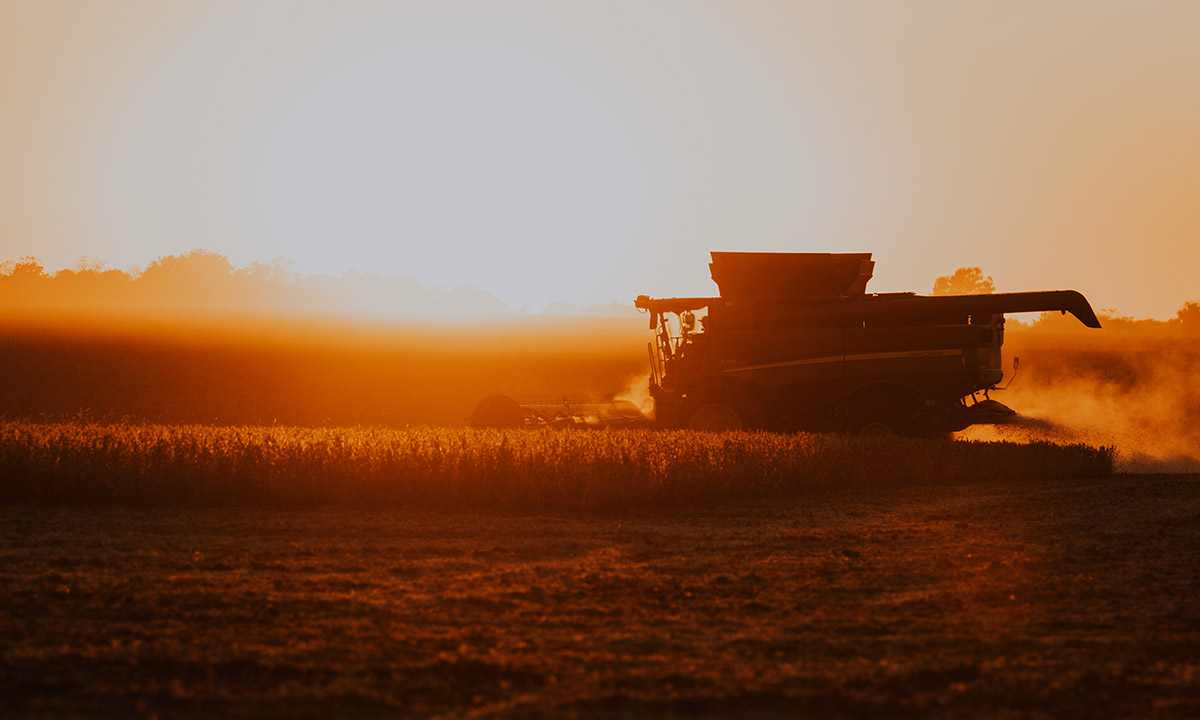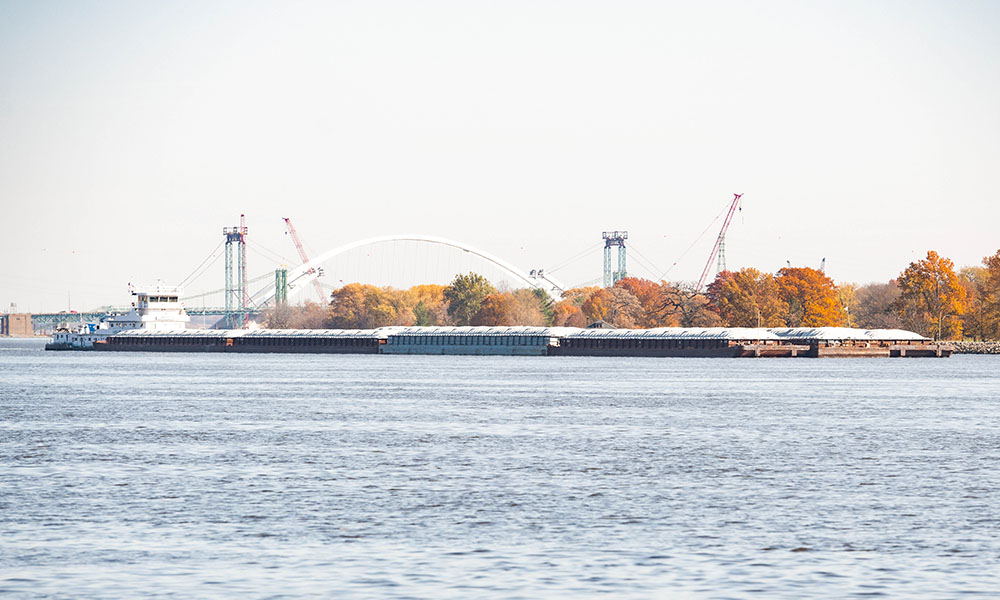
(Photo: Joclyn Bushman/Iowa Soybean Association)
U.S. Soy Global Trade Exchange examines the road ahead for the world of soy
September 23, 2021
Iowa’s farmers don’t just grow crops and raise livestock; they run a business. It’s a difficult task, but it can be made easier when markets are stable and international trade is running smoothly.
At the U.S. Soy Global Trade Exchange (GTE) in St. Louis, attendees learned more about China – one of the Iowa soybean farmers’ largest customers – and the current attitudes at play in the nation, which consumes 60% of the world’s supply of soy.
Simon Rabinovitch, economic editor at The Economist, says decades of commentary and speculation on China typically can be described as falling under the bull and bear dichotomy used by the financial sector.
A bullish China has often been described as an unstoppable force, while a bearish China is considered destined to fall apart.
“As China grows, so does its soybean consumption,” Rabinovitch says. “Many industries are going to face challenges because of an aging population, but people still need to eat.
In the last four decades, reality has leaned closer to the bullish description. However, the country faces several significant challenges as it sets lofty goals for the future.
“People are increasingly prosperous; there may be a little bit less pork, more fish but maybe more beef, a mixture of trends,” Rabinovitch says. “My sense is the population trends, certainly for the next 10 to 15 years, are not going to have a great impact on consumption. They will be relatively neutral for soybeans.”
China’s workforce is improving at an incredible pace, with approximately 8 million earning post-secondary training and college degrees each year. At the same time, China’s demographic situation is changing – the population is becoming fewer and older. The country’s average age today is older than in the U.S. The population’s consumption of soy, however, is not faltering but growing fast.
Rabinovitch says three main challenges are affecting China and the rest of the globe today – trade friction, unbalanced economics and geopolitics. These are familiar topics to Iowa farmers who have endured the fallout from the international trade difficulties of the last half-decade.
“China is trying to become more self-reliant,” Rabinovitch says.
While the relationship between America and China continues to be defined, Rabinovitch says the economic linkage between the two countries is strong and both countries have been benefiting post-Phase One Trade Deal.
“When you look at the economics, the trade relationship is looking very strong,” Rabinovitch says. “Ag exports to China have boomed, and Chinese exports are doing better than they have ever done in terms of global market share. But difficulties may remain on the horizon.”
Politically, things are very tense. “Many people in China thought this would be a new start for U.S. and China relations,” Rabinovitch says. “What we have seen now is American policy toward China has really had a structural shift; whereas in the 1990s and early 2000s, economics took precedence and everything else was playing second fiddle. I think there is a risk that although the economic ties look very strong now, the political foundations for the U.S. China relationship are as tense as they have ever been in the period of normalization and diplomatic relations going back to the late 1970s.”
Supply and demand
Conversations on China’s appetite for soy and attitudes in trade appeared during multiple GTE panels, including one featuring former chief U.S. agricultural negotiator Gregg Doud.
The January 2020 Phase One Trade Deal agreement between the U.S. and China featured 57 structural changes, of which 54 have been completed, Doud says. Additionally, he described China’s banning of swill feeding as one of the most significant changes he has witnessed in Chinese agriculture and trade.
“Half the hogs on the planet are in China and half of those were fed food scraps,” Doud says. “They need 30 million tons of more feed, which changes the dynamic significantly for everyone in the world.”
Using Des Moines as a prime meridian for the drought battering crops across the nation this summer, USDA Chief Economist Dr. Seth Meyer says the expectation for America’s third largest soybean crop is record breaking yields east of Iowa’s capital and an overall increase in export value coming at a beneficial time for America’s farmers.

“Contributing to the rebound in cash receipts for farmers are all the things an Iowan loves – corn, soybeans and hogs and to a lesser extent cattle,” Meyer says. “These are also things the Chinese buy from us in the market.”
The rebound comes at an opportune time for producers, Meyer says with a surge in direct payments related to trade friction and COVID-19.
“What you have is a big decline in ad hoc government payments being replaced by commodity price increases and that’s supporting farm income,” says Meyer.
Vegetable Oil
Soybean oil is expected to feature prominently in 2021. Dorab Mistry, Godrej International Ltd. director, says he remains bullish on vegetable oil prices. The Canadian canola crop suffered under drought conditions, palm oil remains bullish despite fears of output challenges and the sunseed crop is expected to be large this year. Although vegetable oil prices are high, demand disruption has been low.
Calling the biodiesel industry “revived” due to the COVID-19 pandemic and election of Pres. Joe Biden, Dr. Julian McGill, head of Southeast Asia LMC International, says biodiesel demand has increased the demand for soybean oil dramatically.
“Looking at the oil share in the total soybean crush value, it’s normally around 30-35%,” McGill says. “Since the Renewable Identification Number credit values have gone up, it has shot up. This shift means the U.S. is decoupled from the rest of the world.”
Shipping
The shipping industry has also seen dramatic changes due to the pandemic, which is causing headaches for U.S. exporters trying to export soy products.
“In the summer of 2020, we started to see a surge of imports coming back to the U.S. caused by consumer demand that was reactivating and climbing very rapidly,” says Darwin Rader, international sales and marketing manager at Zeeland Farm Services, Inc.
“We saw congestion at the West Coast ports, and the congestion started moving inland and affecting rail,” he continued. “We saw trucking and chassis shortages. Exporters are facing challenges getting bookings, access to containers while ocean carriers continue shipping more empties direct back to Asia.”
A silver lining for farmers whose crops are bound to travel by ocean is while supply ships and containers are in high demand, the demand for grain and ag commodities in 2022 is also expected to continue to increase, according to Guy Hindley, managing partner at Dry Cargo Howe Robinson Partners.
“The ships carrying grain are also now in more demand for places like Columbia, which are no longer taking the very big ships or in the same volume they once were,” Hindley says.
Carl Bentzel, Federal Maritime Commissioner, says the high demand shipping situation will likely continue into next year.
“Hopefully, during the Chinese New Year timeframe [February] there will be some alleviation because the Chinese production will slow down,” Bentzel says. “Buyers are putting a lot of pressure to get as much capacity as possible.”
Bentzel says he’s hearing that China is chartering different types of vessels other than container vessels because there’s no capacity left.
“Hopefully, some of the issues of congestion can be worked out to mitigate some of the issues, but it’s not inconceivable it could go on past that time,” he says.
This story was originally published in the October 2021 issue of the Iowa Soybean Review.
Back